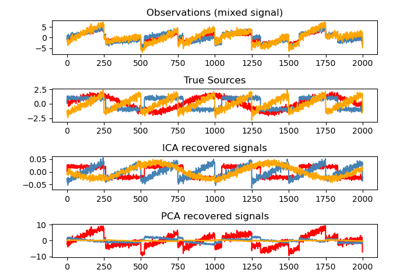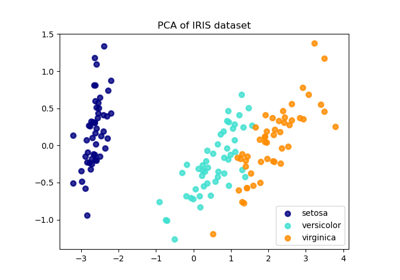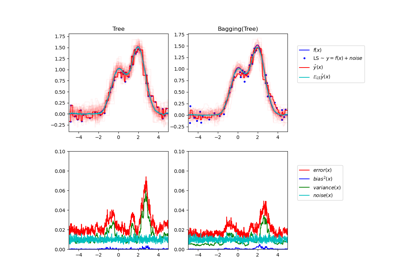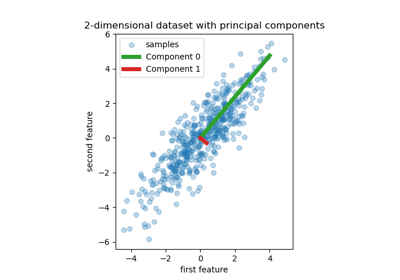注意
前往页面底部 下载完整示例代码,或通过 JupyterLite 或 Binder 在浏览器中运行此示例。
FastICA 在二维点云上的应用#
本示例以可视化的方式在特征空间中比较了两种不同成分分析技术的结果。
在特征空间中表示 ICA 提供了“几何 ICA”的视角:ICA 是一种在特征空间中寻找与高非高斯性投影相对应的方向的算法。这些方向在原始特征空间中不必是正交的,但在白化特征空间中它们是正交的,其中所有方向都对应相同的方差。
另一方面,PCA 在原始特征空间中寻找正交方向,这些方向对应于解释最大方差的方向。
这里我们使用高度非高斯过程模拟独立源,即 2 个自由度较低的 Student T 分布(左上图)。我们将它们混合以创建观测值(右上图)。在这个原始观测空间中,PCA 识别的方向由橙色向量表示。我们在 PCA 空间中表示信号,经过与 PCA 向量对应的方差白化后(左下)。运行 ICA 对应于在这个空间中寻找旋转,以识别最大非高斯性的方向(右下)。
# Authors: The scikit-learn developers
# SPDX-License-Identifier: BSD-3-Clause
生成样本数据#
import numpy as np
from sklearn.decomposition import PCA, FastICA
rng = np.random.RandomState(42)
S = rng.standard_t(1.5, size=(20000, 2))
S[:, 0] *= 2.0
# Mix data
A = np.array([[1, 1], [0, 2]]) # Mixing matrix
X = np.dot(S, A.T) # Generate observations
pca = PCA()
S_pca_ = pca.fit(X).transform(X)
ica = FastICA(random_state=rng, whiten="arbitrary-variance")
S_ica_ = ica.fit(X).transform(X) # Estimate the sources
绘制结果#
import matplotlib.pyplot as plt
def plot_samples(S, axis_list=None):
plt.scatter(
S[:, 0], S[:, 1], s=2, marker="o", zorder=10, color="steelblue", alpha=0.5
)
if axis_list is not None:
for axis, color, label in axis_list:
x_axis, y_axis = axis / axis.std()
plt.quiver(
(0, 0),
(0, 0),
x_axis,
y_axis,
zorder=11,
width=0.01,
scale=6,
color=color,
label=label,
)
plt.hlines(0, -5, 5, color="black", linewidth=0.5)
plt.vlines(0, -3, 3, color="black", linewidth=0.5)
plt.xlim(-5, 5)
plt.ylim(-3, 3)
plt.gca().set_aspect("equal")
plt.xlabel("x")
plt.ylabel("y")
plt.figure()
plt.subplot(2, 2, 1)
plot_samples(S / S.std())
plt.title("True Independent Sources")
axis_list = [(pca.components_.T, "orange", "PCA"), (ica.mixing_, "red", "ICA")]
plt.subplot(2, 2, 2)
plot_samples(X / np.std(X), axis_list=axis_list)
legend = plt.legend(loc="upper left")
legend.set_zorder(100)
plt.title("Observations")
plt.subplot(2, 2, 3)
plot_samples(S_pca_ / np.std(S_pca_))
plt.title("PCA recovered signals")
plt.subplot(2, 2, 4)
plot_samples(S_ica_ / np.std(S_ica_))
plt.title("ICA recovered signals")
plt.subplots_adjust(0.09, 0.04, 0.94, 0.94, 0.26, 0.36)
plt.tight_layout()
plt.show()
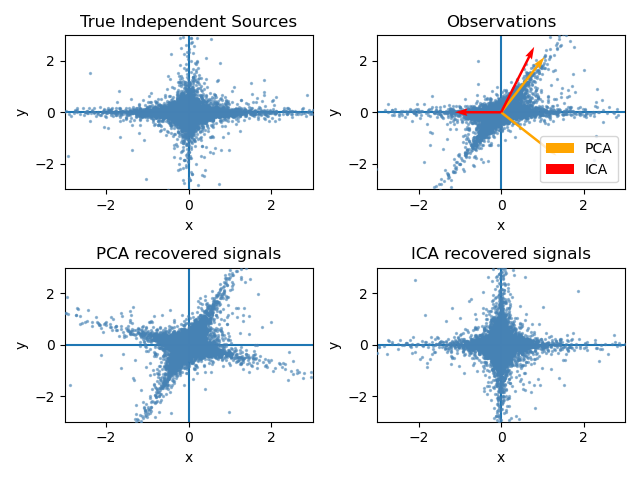
脚本总运行时间: (0 分 0.355 秒)
相关示例

